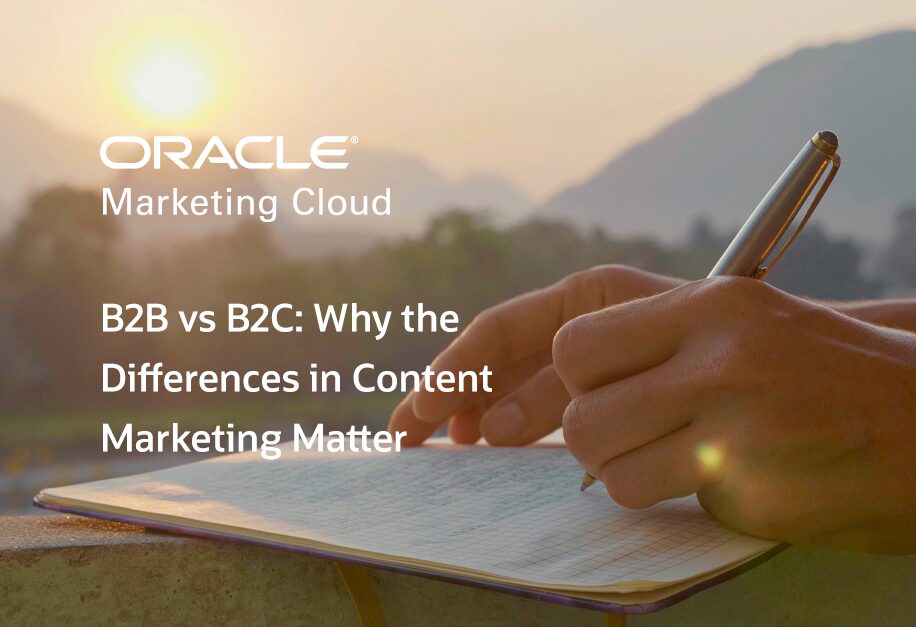
In this age of personalization, it’s become even more important for a brand to acknowledge that they are speaking to a specific audience with their own unique set of needs, challenges, and interests.
Nowhere is this more apparent than in looking at a B2B audience versus a B2C audience. Here’s what should be different about the content approach for each audience and what it matters.
Different Decision-Makers
Your business decision-makers are typically leaders within a company that have specific responsibilities and set of goals to achieve. Their purchase decision-making, although grounded in the same overall need, is different than that of a consumer decision maker.
In contrast, the consumer may make different decisions based on the others included in their decision and the reason for the purchase. In these scenarios with the consumer, the purchase behavior can change or evolve over time while a business tends to maintain its purchase behavior parameters.
While your B2B content may vary slightly, there are rarely any new major scenarios to address like a consumer may experience. However, that doesn’t mean your B2B content marketing strategy should be static. You’ll still need to work directly with your business audience to understand if they base decisions on a new budget, an emerging issue, or an elevated business model.
Alternate Perspectives
Since consumers tend to feel like they are masters of their purchase decisions unlike business decision makers, consumer perspectives may align with trends, demographic and social changes, cultural foundations, and lifestyle modifications. Things like travel, job changes, and major life events also influence their perspectives.
However, as a B2B marketer, you won’t be able to use the same factors to determine perspectives. Also, you will have to understand how the business decision maker’s perspective focuses solely on a strategic endeavor while others in the company take a technical perspective or have a financial perspective. Yet, if you are a global company, working in different countries, your content will also need to include the cultural belief and values system of each audience’s location.
If you don’t address all these distinct perspectives as a content marketer in either case, you’ll be missing out on opportunities to truly engage and capture your specific audience.
Unique Needs and Intent
A business has completely different needs than a consumer due in large part to their daily activities and purpose. Your content marketing will need to reflect that you know what those needs are along with the intent for a certain purchase.
For example, a business may need to become more productive, efficient, and cost effective in its operations. Therefore, a company’s intent is to find a solution that can help them make those improvements. Their intent may also be to see a demo, get training, or upgrade their current solution.
On the other hand, a consumer might need a product that addresses a need related to themselves or their health, family, home, vehicle, or gift or event. While their end intent is to buy, their initial intent may involve collecting more information, comparing prices, and identifying a place to make the purchase.
In all cases, you’ll need to identify the need and intent and then illustrate that understanding in your content marketing.
Diverse Influences
While a consumer buys a product because of an actor or celebrity in your content marketing campaign, a business decision maker looks to an influencer that may be a credible researcher, colleague, or admired business leader. They don’t put the same stock in the credibility that a consumer may give a famous person.
Differing Content Formats, Channels, and Timing
One of the biggest differences between B2B and B2C is the content format, channel, and timing. While more businesses are starting to embrace mobile and social channels for content, they also still like to receive emails, newsletters, blog posts, and landing page content. B2B content must also include other formats that a consumer might not be as interested in like research reports, infographics, and white papers. If you don’t deliver these B2B formats on their preferred channels, you’ll miss interacting and engaging a significant portion of your target audience.
And, B2B content marketing isn’t just about the message, format, or channel. Timing is also a differentiating factor from the consumer content side.
You’ll need to research when your business audience typically goes online, reads their email, or uses their mobile devices to look for answers. This is also critical for reaching the right audience at the most opportune time in their decision-making process.
Don’t Forget the Similarities: We’re All Human
However, you are also making a mistake if you don’t acknowledge some similarities in terms of approach. Both audiences want to hear what you can do for them rather than about your company and achievements. They are looking for specific value and insights that specifically help them make improvements, solve problems, or accomplish goals. They want a partner, not a salesperson.
Also, don’t assume a consumer audience wants funny content but your business audiences prefer formal. It’s a mistake to define differences this way. Instead, you have to look at each business or consumer prospect individually to determine what they really want from you and then craft the content from that perspective.
In this way, you will be taking a P2P perspective no matter what business you are in — that’s a person-to-person approach to your content marketing. That involves studying business-related media and content on sites like BuzzSumo and Google News to see what’s trending and most read. It also means reading what your audience comments on and shares in online forums, groups, and social media discussions. Get to know what’s different about them, address those things, and win and retain them as loyal B2B customers.
Blogging can help build your position as a thought leader and help nurture prospects. It is an integral part of content marketing. Find out how to “Do More with B2B Blogging” and see how it differs from B2C blogging.
